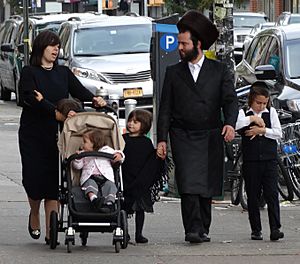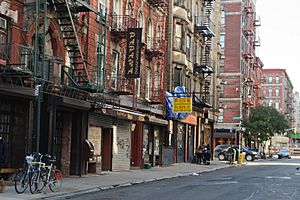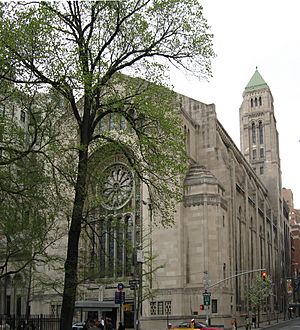History of the Jews in New York facts for kids
Jewish people have lived in New York state since the 1600s. In August 1654, the first known Jewish settler, Jacob Barsimson, arrived in New Amsterdam. This Dutch port city was the main government center for the New Netherland territory. It later became New York City in 1664.
The first large group of Jewish settlers came in September 1654. They were refugees from Recife, Brazil. Portugal had just taken over Brazil from the Dutch Republic. The Spanish and Portuguese Jews living there quickly left. A group of 23 Jewish immigrants arrived in New Amsterdam. The leader, Peter Stuyvesant, did not want to accept them at first.
The number of Jewish people in New York City grew a lot. It went from about 80,000 in 1880 to 1.6 million in 1920. By 1910, over 1 million Jews lived in New York. This made up 25 percent of the city's population. It became the world's largest Jewish city. As of 2016, about 1.1 million New York City residents were Jewish. This is about 12 percent of the city. New York state has about 1.75 million Jews, which is about 9 percent of its total population.
Contents
Early Jewish Arrivals in New York
Who Was Jacob Barsimson?
Jacob Barsimson was the first Jewish immigrant to reach New Amsterdam. He arrived on August 22, 1654. He sailed on a Dutch West India Company ship called the Peartree. He had the right papers and faced no problems from Governor Peter Stuyvesant. Jacob Barsimson and Asser Levy worked hard to let the first group of 23 Jewish immigrants stay in New Amsterdam.
The First Big Group of Jewish Immigrants
The first large group of Jews came to New York after Jacob Barsimson. This group of 23 Jewish immigrants arrived in September 1654. They were escaping the Inquisitions in Spain and Portugal. After Jews were forced out of Spain in 1492, and many were forced to change their religion in Portugal, many fled. They went to different parts of Europe and the New World. Dutch Brazil became a safe place for many, and a Jewish community grew in Recife.
In the 1650s, Portugal took back control of Dutch Brazil. The Inquisition, which was a time of religious persecution, soon followed. Many Jewish residents of Recife left after Portugal took over. They tried to return to New Amsterdam. One ship, the St. Charles, had to change its path. Pirates attacked it on its way to Holland. After trying to land in several Spanish ports, they finally arrived in New Amsterdam without passports.
These immigrants had signed a contract with the captain of the St. Charles. They agreed to pay for their trip to New Amsterdam. But when they arrived, they did not have enough money. Governor Peter Stuyvesant sold their belongings to pay the fees. Since they still did not have enough money, two people were put in prison.
Governor Stuyvesant did not want them to settle there. He said they did not have the right papers or enough money. Jewish people already living in New York sent a letter to the Dutch West India Company. They asked for the immigrants to be allowed to stay. They said there was plenty of land. They also argued that more loyal people would help the company grow its colony. Jewish people who owned shares in the Dutch West India Company convinced the company to tell the governor to accept the new arrivals. However, the governor still put many rules and taxes on his Jewish subjects. Eventually, many of these Jews left. The company overruled the governor's objections on February 15, 1655. After that, Jews were allowed to travel, trade, and live in the New Amsterdam Colony.
Who Was Asser Levy?
Asser Levy was one of the first 23 Jewish immigrants. He helped to create requests that won the immigrants the right to live in New Amsterdam. He was a strong supporter for Jews in the colony. Court records from New Amsterdam first mention Asser Levy on September 15, 1654. He was complaining about unfair treatment of Jewish immigrants. For example, Levy protested a rule that said Jews did not have to join the army but had to pay an extra tax instead.
Jewish Life in the 1800s and 1900s
The second main period for Jewish people in America involved many German Jews. Many Jewish people looked for peace and a new life. In the 1800s, New York was a great place for this. Many settlers started careers in arts, business, and writing. Between the 1830s and 1880s, more and more middle-class German Jews came to New York. They were escaping unfair treatment and seeking success. As the city grew, so did the Jewish population. In 1848, German Jews in New York started B'nai B'rith. This was the first big non-religious Jewish organization.
When the American Civil War began, about 7,000 Jews fought for the Union. About 1,500 fought for the Confederacy. After the Civil War, Jewish people in New York became more divided by religion. A new movement called Reform Judaism became very popular.
The Great Wave of Jewish Immigrants
Between 1880 and 1924, 2.5 million Ashkenazi Jews came to the United States. They came from the Russian Empire, Romania, and Austria-Hungary. Nearly 75 percent of them settled in the Lower East Side of New York City. The Jewish population in New York grew from about 80,000 in 1880 to 1.5 million in 1920. This new mix of cultures changed the Jewish community. It went from being mostly middle-class and politically traditional to a working-class, Yiddish-speaking group. They had many different ideas, including socialism, Zionism, and traditional religious beliefs.
The number of Jews in the city reached over one million by the 1900s. They crowded into Jewish neighborhoods. They were not stopped from renting homes there because of unfair rules. These rules lasted until the end of World War II. Less fortunate Jewish people made the Lower East Side their own area. This happened as many Jews arrived in the city between the 1870s and early 1900s.
Jews in Central and Eastern Europe faced hard times. They dealt with economic problems, unfair treatment, and big social changes from the 1800s to the early 1900s. This caused them to flee to the United States. In Russia, there were many attacks called pogroms between 1881 and 1921.
In 1940, 90% of New York state's 2,206,328 Jews lived in New York City. However, in the next 20 years, many moved to the suburbs outside the city.
Jewish Contributions to New York
Jewish Culture in New York
Jewish people also found ways to keep their traditions alive. They also brought new cultural things to New York City.
The bagel came to the United States in the early 1900s. It became so popular that it is now sold all over the world. The recipe was closely guarded by Bagel Bakers Local 338. This was a group of 300 bagel makers based in New York.
Jewish Religious Life
The first Jewish group in the city was Congregation Shearith Israel. It was started in 1654. Temple Emanu-El of New York was founded in 1845. It is on 5th Avenue in Manhattan's Upper East Side. It is the oldest Reform Jewish group in New York City. It grew to be the largest and most respected Reform group in the country. The Angel Orensanz Center was first called Anshe Chesed Synagogue. It is in the Lower East Side. It was the largest synagogue in the United States when it was built. The building has been standing since 1849, making it the oldest synagogue still around.
Most people living in Borough Park are Orthodox and Hasidic Jews. This area in southwestern Brooklyn first had Jewish residents in the early 1900s. Hasidic immigration began after World War II. Survivors from Nazi extermination camps and Eastern European ghettos arrived then.
Science and Learning
Many Jewish people studied science and moved to New York City. One example is Otto Loewi. He moved to the United States in 1940. He joined the New York University College of Medicine as a research professor. He won the Nobel Prize in Physiology or Medicine in 1936. He shared it with Henry Dale.
Literature and Theater
From the late 1800s to the early 1900s, Jewish people began to share their theater art in New York City. The Yiddish Theater was started in 1903. It used the Yiddish language, which Jews in central and eastern Europe spoke before the Holocaust. The Yiddish theater mostly had Jewish actors and settlers in New York. They performed Yiddish plays and folk stories. This helped theater culture grow throughout the city.
Many Jewish actors and writers in the 1900s and 2000s have made a big impact on the theater world. Famous examples include Tony Curtis, Stephen Sondheim, Scarlett Johansson, and Barbra Streisand.
Notable Events
Teachers' Strike of 1968
The New York City teachers' strike of 1968 was a major event. It involved a conflict between teachers and the local school board.
Crown Heights Riot of 1991
The Crown Heights riot happened in 1991. It was a period of unrest in the Crown Heights neighborhood of Brooklyn.




